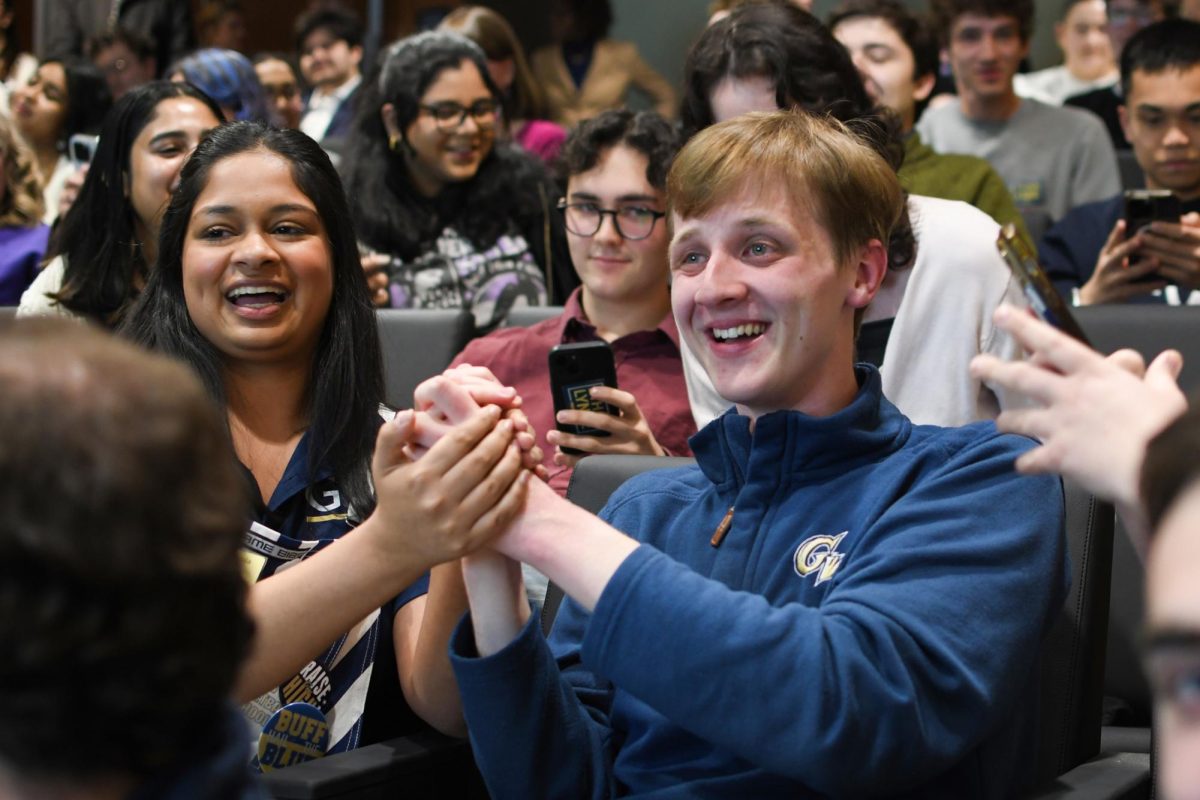Visions of scientific prestige and research will begin to take form when University officials break ground on the Science and Engineering Hall Thursday.
Faculty and administrators are hinging their hopes that the four-year construction project will unify and improve GW’s science and engineering programs through upgraded resources and a heightened ability to attract high-quality students and faculty.
The $275-million building – the most expensive in GW’s history – is the centerpiece of the University’s broad mission to revitalize research and jump-start the School of Engineering and Applied Science, ranked No. 102 nationally.
The immediate effects of the push will be felt by faculty and students, who say the facility will dramatically improve their daily lives in labs and classrooms.
“Right now, we’re doing in one square foot what other universities are doing in four square feet. We don’t have room to blossom,” civil and environmental engineering department chair Kim Roddis said. “The new teaching laboratories will be providing a 21 century-quality learning environment.”
Roddis hopes the building’s eight stories and 480,000 square feet will catapult GW’s science and engineering facilities from outdated to state-of-the-art when it opens in 2015.
The hall will feature studio labs that combine lecture and lab spaces, a clean room that is critical for sterilizing research environments and interdisciplinary space that will house all the sciences and engineering departments at GW under one roof.
The Science and Engineering Hall was conceptualized before University President Steven Knapp’s tenure began in 2007, and the Board of Trustess approved the project in October 2010. The D.C. Zoning Commission green-lighted the project in July 2011, after repeated challenges from Foggy Bottom’s primary advocacy groups, which questioned the long-term effects of the project on the neighborhood.
The upgrades come at the right time, Mona Zaghloul, chair of the department of electrical and computer engineering, said, since the University currently lacks space and technical resources in several important areas of modern science, like atom-level imaging and nanotechnology.
“If you look at many other schools, even around us in the Washington area, you’ll see most of the schools have state of the art facilities, and the students are exposed to the latest technology,” Zaghloul said. “We really need that. From the education point of view, this is a huge step.”
One of those schools is the University of Maryland, a No. 22-ranked engineering school that GW looks to as a model for success. William Fourney, a mechanical engineering professor at UMD, touted the positive impact a new building completed in 2005 had on the engineering school’s image.
“Visitors see that the college is doing cutting edge research and there’s no old, downtrodden laboratories in there,” Fourney said. “It just puts a whole new light on the advances being made by the students and the faculty in the school of engineering.”
For GW physics professor Mark Reeves, the Science and Engineering Hall will provide unity for the science and engineering departments that are now sprawled across campus, with faculty offices in Phillips Hall, classrooms in Tompkins Hall and several other functions falling in between.
By bringing science departments in the Columbian College of Arts and Sciences and the engineering school together in a single location, the building will also allow for a rebirth of science and technology at GW, Reeves said.
“You start with a blank slate and you have the opportunity to get things just right,” Reeves said.
Edward Derrick, the director of science and policy programs at the nonprofit American Association for the Advancement of Science, said universities can successfully fill that blank slate with a defined vision.
“You have to keep the momentum going. It’s keeping this large vision in place of where the institution is going that really makes a different,” Derrick said. “You need to have a long-term plan of knowing what’s going to happen once it’s built.”
Derrick said that vision could become a mirage, as the construction begins at a time of national uncertainty for many engineering schools.
Because of congressional budget cuts, Derrick said, universities are facing a “challenging to time to seek federal funding” from organizations like the National Science Foundation, which have provided grant money to help GW’s engineering school develop one of their top research tools, an earthquake simulator.
“Usually you’re looking forward to going to a new building, but you’re doing this in very difficult times,” Derrick said.
Economics professor Anthony Yezer, who specializes in real estate economics, said the deck is already stacked against science and engineering at GW because of the school’s urban location.
“I’m not trying to say engineering isn’t very important for the nation, but can you name a top-flight or a second-to-top flight engineering school that’s located near the center of a top American city?” Yezer said. “There’s a reason why. Space is too expensive.”
GW plans to fund the complex through debt, revenue from The Avenue and fundraising. Senior University officials have expressed hope to bring in at least $100 million in fundraising to support the building.
David Dolling, the dean of the engineering school, said he “plans to fully leverage the investment in the [Science and Engineering Hall] by growing our research programs, the size of our faculty and the quality of our education.”
He added that the prospects and promise of the Science and Engineering Hall are already drawing top faculty and students to the school.
The engineering school has hired 32 new faculty in the last four semesters and enrolled a freshman class this year with 6 percent more students who graduated in the top 10 percent of their high schools.
As faculty and student quality climb, the dean expects academic and research rankings to follow.
“In our domain of the campus, the young person who is interviewing will see what will rise out of the ashes of the construction: a phenomenal new building,” Dolling said last month. “It’s an enormous attraction, and I think also there’s a psychology where people want to be part of something that’s getting better and growing.”
Though most current students will never use the building’s labs, some still feel they will reap the benefits. Senior Matthew Wilkins, a biological engineering major, said student and faculty input into the building’s design has been rewarding.
“By the time I hit the work force, the building will have made substantial strides for the school of engineering, which will make my degree worth more,” Wilkins said. “I’m pretty excited about that.”






